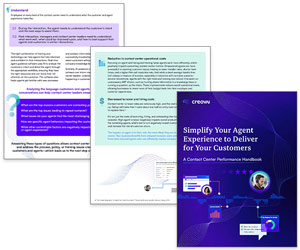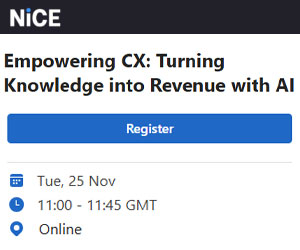In this article, we address the thorny question of how to measure engagement and look at the best questions to include on an Employee Engagement survey.
Employees are key to success in the contact centre. There is a clear link between engaged employees and the level of customer service that you can provide.
The Employee Engagement Score – A Simple Way to Calculate Engagement
The most common measure of engagement is to create a Employee Engagement Score through a survey.
This can be supplemented by other indicators that are proxies for engagement. This includes absence and attrition rates, as well as indirect factors such as Customer Satisfaction (CSAT) or NetPromoter Score.
In addition, there is no substitute for walking round the company and talking with people. Good leaders will instinctively have a good feel for the mood of the company and how engaged everyone is.
However, for now, let’s look a little more closely at how we can use surveys to calculate a trackable engagement Score.
How to Work Out a Trackable Employee Engagement Score
The simplest way to produce a trackable Employee Engagement Score is to apply a weighted average across the 4 or 5 questions that you ask in every survey.
You then add in a weighting factor so that the total adds up to 10.
Here is an example:
Question 1 – Would you recommend the company as a place to work to a close friend/family member? (The NetPromoter type question – This is on a score of 1 to 10, where 10 is most likely)
- 9–10 = 3 points
- 7–8 = 2 points
- 6 = 1 point
- 4 or 5 = 0 points
- 3 or less = -1 point
Question 2 – When did you last get recognition for doing a good job?
- Past week = 3 points
- Past month = 2 points
- Past quarter = 0 points
- Never = -1 point
Question 3 – Do you trust your manager?
- Yes = 2 points
- Somewhat = 1 point
- No – 0 points
Question 4 – Do you have a best friend at work? (or someone at work who you could confide in)?
- Yes = 1 point
- No = 0 points
Question 5 – Do you feel that you have received enough training to do a good job?
- Yes = 1 point
- No = 0 points
The Formula for an Employee Engagement Score
From the example above, we can put together a formula like the one below to calculate a score.
Employee Engagement Score = Question 1 + Question 2 + Question 3 + Question 4 + Question 5
You now have a score from -2 to 10. You can simply average this across employees so that you can track progress.
It is important that you do not share too widely how this scoring system is worked out or you may find that some team managers try to “game” or manipulate the scores – for example by giving out lots of praise in the week before the survey comes out.
Tracking Progress Across Time
In order to track progress of your engagement Score over time it is essential that that you consistently ask the same questions across every quarter. In this way, you can build up a fair comparison.
If you find that one question is not really working for you it is possible to bring in a new question. However, you would need to run it in parallel for a few quarters to able to compare it against the question that you are looking to change – so you cab eventually track uour Employee Engagement Score as you did before.
Pre-Designed Surveys

Rather than designing your own survey, you may be able to use a pre-designed Employee Engagement Survey.
Gallup have done a lot of work on this and have come up with a standardised list of 12 questions or statements that they ask.
This is a sample report from Gallup Q12 includes 12 engagement statements, including the three below, which advisors have to score, from one to five, how much they agree with them:
- In the last seven days, I have received recognition or praise for doing good work.
- The mission or purpose of my company makes me feel my job is important.
- I have a best friend at work
How Many Questions Should You Ask in Your Employee Engagement Survey?
There is no right or wrong answer here. Most companies operate surveys in the range of 5 to 25 questions.
As a rule of thumb, if you ask between 10 and 12 questions you should be able to get an optimum level of participation and feedback.
We would suggest that your 10-12 questions look something like this:
- 4 or 5 Calibration questions – These are the questions that are identical every quarter that you can use for tracking engagement across time.
- 4 or 5 Fact-finding questions – These are questions that you use to discover the attitudes of your staff and how they are being managed, but are not tracked over time.
- 2 to 4 Voice of the Employee questions – These are open questions with text boxes that allow staff to articulate their frustrations as well as offer suggestions of how things could be improved.
In the interest of calculating a score, we want to be focusing on calibration questions and only use fact-finding and Voice of the Employee for additional research.
If you need to ask more questions, you can do this in the optional “fact-finding questions” as part of the next quarterly survey, which will not be included into your score
How Often Should You Calculate an Employee Engagement Score?

Best practice has found that you should survey all of your employees at least once a year.
This is usually implemented as an Annual Employee Survey. The downside of an annual survey is that it only provides one measurement point per year and can be viewed as the annual “sheep dip” exercise – the results of which could be ignored for the next 12 months.
Smarter companies now carry out a quarterly Employee Survey, allowing look for trends in their Engagement Score every three months.
In order to track the survey across time you should survey 25% of your employees every quarter. In this quarterly survey, you should ask a number of calibration questions (ideally 4-5) that are consistent across each quarter so that you will be able to track trends.
Be Careful of the Dangers of Calculating an Employee Engagement Score Each Quarter?
The general principle is that we must calculate an Employee Engagement Score by the quarter, as it gives us more actionable insight into engagement rates are changing, than if we were to do so annually.
While this is true, we must be wary of the problems that we will face when trying to measure Employee Engagement on a quarterly basis.
Here are seven such problems that we may run into:
1. Employees may not answer truthfully. This is particularly the case if there is a belief that answers could be attributed back to the individual (the best Employee Surveys are anonymous).
2. Managers may influence the results. With questions such as “When did you last receive positive feedback?” or “Do you trust your manager?” managers may try to influence results, for example standing over someone while they complete the survey or telling staff not to bother filling it in.
3. Low participation rates. When surveying annually it is easier to communicate a message that the survey matters. With quarterly surveys you may find a lower participation rate.
4. It can be very hard to change engagement over time. A common complaint is that “the dial is stuck on the same level” – a lot of initiatives may be brought in but the Employee Engagement Score remains constant.
5. Results can be inconsistent. As with any survey, it can be highly influenced by external factors such as the weather, bad news such as redundancies being announced or poor market factors.
6. People tune out the measurement. When a measurement is done on a quarterly basis, there is a possibility that people can tune it out.
7. If it is used as a target. Goodhart’s law states – “When a measure becomes a target, it ceases to be a good measure.” This is named after the economist who originated it, Charles Goodhart.
‘Pulse Points’ Can Help Capture Weekly Data
In addition to the quarterly survey you could also carry out some regular ‘pulse points’ of the organisation. This could be in the form of a happy or sad face or could be in response to weekly questions.
We can also create an Employee Engagement Score using this method, as we track it more regularly.
“We use an annual survey combined with an open ‘Pulseometer’ for daily feedback. This is a forum-based in-house built tool that colleagues can post feedback as and when they need – under topics such as incentives, product, ideas etc… They receive a response within 24 hours that others can also see and comment upon.”
“The Pulseometer also records sentiments of unhappy, indifferent and happy through an emoji-type icon.” – Thanks to Susanne
“We have a pulse check that when the employees log on they can either hit a sad face or a happy face, then the team manager will pick up with those who have sad faces.” – Thanks to Liz
12 Tips For Increasing Your Employee Engagement Score
Here are some tips that have been sent in by our readers for boosting your score.
1. Give Time Off the Phones to Complete the Survey
We book our teams offline for 30 mins to complete the survey together so they have time to think about their answers and reflect on the past few months.
Thanks to Pamela
2. Line Managers Are Key to Employee Engagement
Line managers are integral to engagement because they have such an influence on the drivers of your Employee Engagement Score, such as; reward, recognition, co-workers, sense of accomplishment, etc.
If you haven’t already, it’s worth having a workshop with line managers in your organisation to stress how much they matter and give tips on how they can increase engagement throughout the company.
Thanks to Shona
3. Communicate New Job Opportunities

We’ve introduced an opt-in text service to text people who want to know when new jobs or development opportunities are announced as well as emails on the back of this feedback
Thanks to Pamela
4. Provide Feedback on What You Have Done as a Result of Surveys
Updating staff throughout the year on what’s been done as a result of their feedback helps them to understand that it’s taken seriously.
I think it’s important that people see that action is being taken on the back of the results, otherwise they won’t be as enthusiastic about filling it in next time.
Thanks to Pamela
5. Engage Staff as Part Of the Wider Family
One part of our strategy is featuring staff in our advertising campaigns (they volunteer), and we also did a meet-the-team video for our social channels.
We even brought some pets into the office for the day. It was great fun for everyone.
Overall, this really helped give our Employee Engagement Score a real boost!
Thanks to Naomi
6. Development and Promotion Opportunities Help to Show How People Are Engaged
We know that people are engaged when they want to be developed and we have internal promotions. If people are not engaged they do not want to progress.
If there are more requests for work shadowing, applications for internal vacancies, that’s a good indicator of engagement.
If internal staff don’t apply for vacancies advertised internally, they are probably not engaged.
Thanks to Liz, Florence and Shona
7. Give Visibility to the Board
Employee Engagement Surveys help influence the board regarding questions about pay – it helps justify pay enhancements to the directors.
Thanks to Jules
8. “Refer a Friend” Schemes

There are many indirect measures of Employee Engagement, so don’t think of it only through the lens of an Employee Engagement Score
We have a refer-a-friend scheme when we are doing a recruitment drive for new agents (if they pass probation, the person referring gets £250).
We find it’s an indication of engagement when the number of people sharing the vacancy on social media is higher than previously.
Thanks to Shona
9. Senior Management Need to Be Approachable
We do a ‘back to the floor’ day and all managers have to go in and sit with advisors. We do it monthly and it’s very powerful.
Also, it’s great to have the senior leadership out on the floor. But this needs to be consistent and not just for a couple of weeks before the engagement survey comes out, as staff see straight through this.
Thanks to Liz and Pamela
10. Make It Anonymous
We use anonymous surveys which hide the IP address of the respondents. It encourages honesty.
Thanks to Jules
11. Transparency Is Important
As a company, you need to be very transparent. Agents should be fully aware of the company goals and have the ability to follow the progress over time.
If they can see that they make a difference it will engage them to walk the extra mile.
Thanks to Mea
12. Your Systems and Processes May Frustrate Employee Engagement
How people feel about coming to work is different from how they feel about the work they do. Your people come to work to do a good job, but if your systems and processes frustrate them, their engagement level will be low.
Thanks to Nicky
Thanks to Dave Salisbury, Nathan Millward, Brian Zotti, Jim Robertson, Robert Cosgrave, Connor Bourke, Liz, Mea, Pamela, Nicky, Shona, Shaun, Jules and Naomi for their input into this article.
Find more ways for calculating a contact centre engagement metrics in our article: How to Measure Employee Engagement
Author: Jonty Pearce
Reviewed by: Megan Jones
Published On: 27th Apr 2016 - Last modified: 18th Aug 2025
Read more about - Call Centre Management, Dave Salisbury, Employee Engagement, How to Calculate, Management Strategies, Metrics, Robert Tuck









































This article is really useful. We used to do a once every 2 months survey and stopped the practice due to low participation rate. What level of participation rate for a quarterly staff survey do you think is considered a success?
I would think that you need a minimum response rate of 10%. If you are not getting this it is probably because people don’t see any change as a result of these surveys. The only way around this is a “you said, we did” style of communication, so that people get the idea that the survey makes a difference.
You also need to reduce the survey frequency as you may be getting survey fatigue.